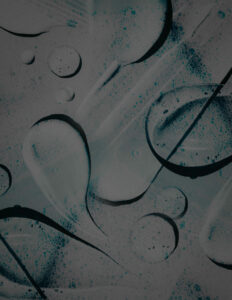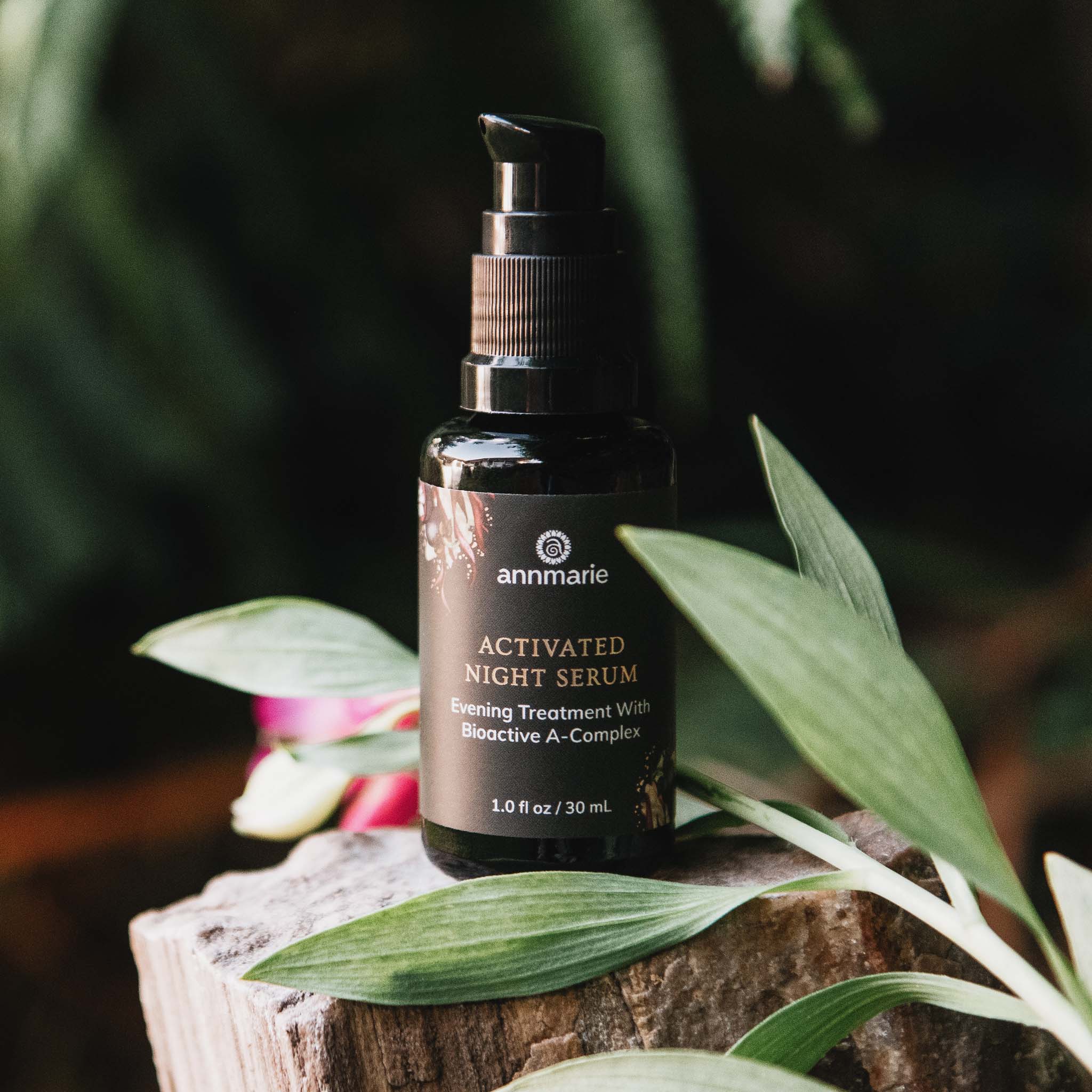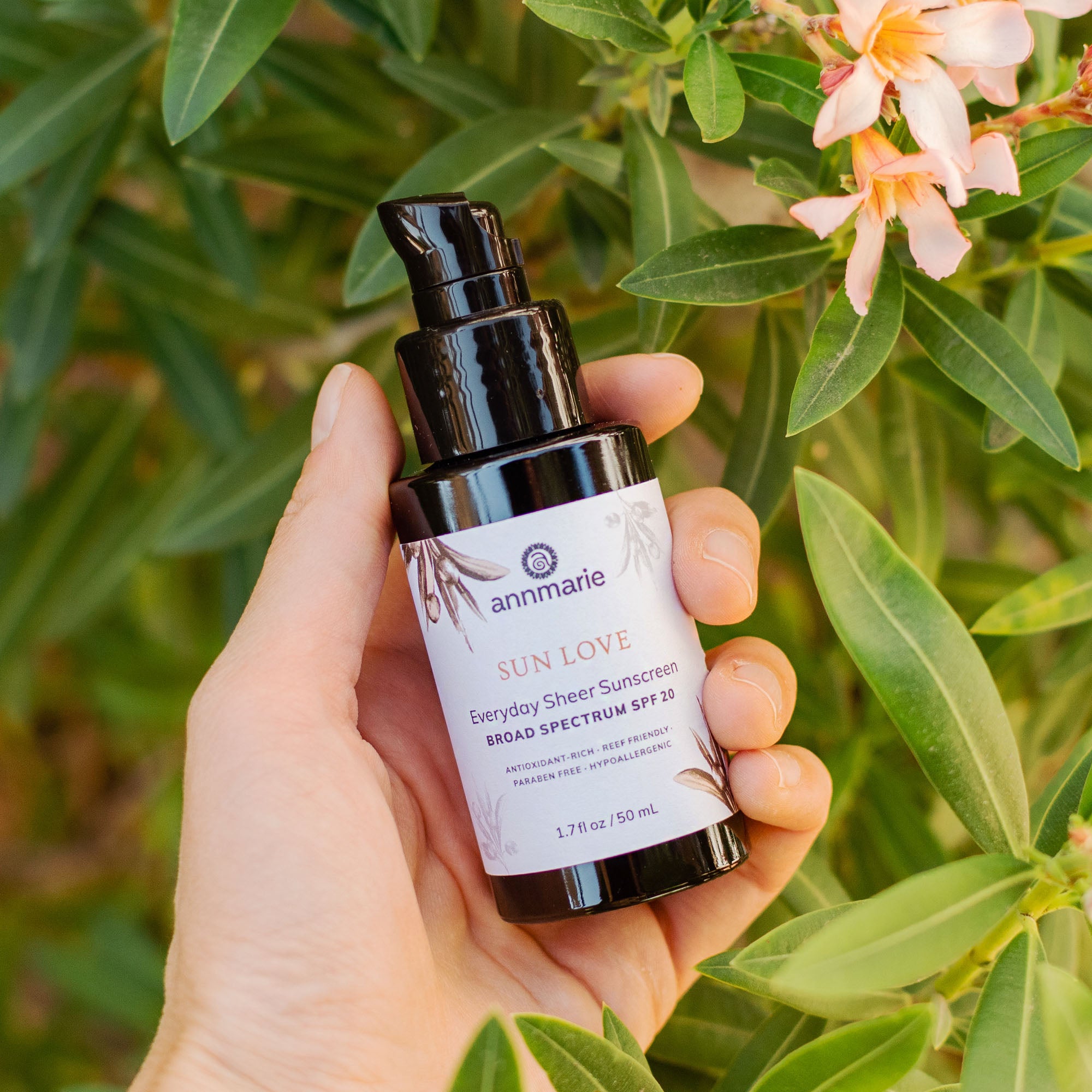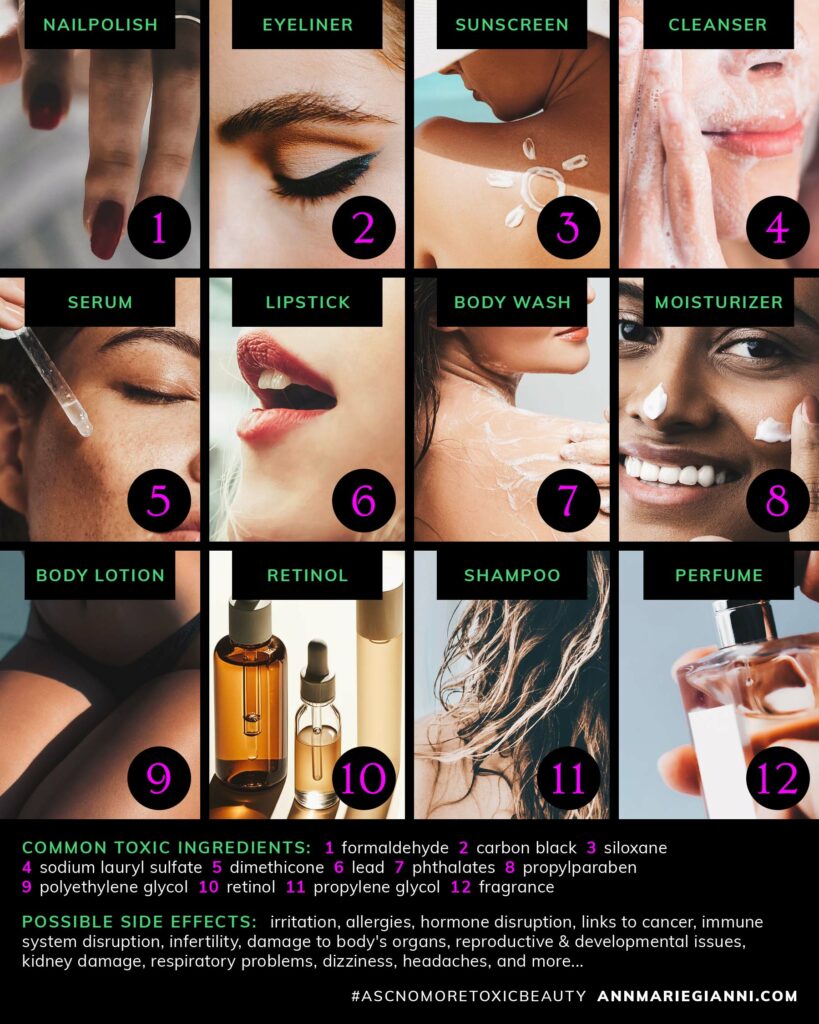
PARTICIPATE IN THE Get Rid of One Toxic Product Challenge
1. Identify the toxic product you're getting rid of
2. Film your commitment
3. Challenge others to join you in this challenge
4. Share your video on social media, tag @annmarieskincare and #ascnomoretoxicbeauty
getting free annmarie skin care has never been easier
Annmarie Skin Care is giving away hundreds of products. By products, we mean clean, natural beauty products that are safe for you and the planet. Join the challenge to claim yours.
Click any of the links below:

How To partiCIpate
1. Identify the Toxic Product
Identify a toxic product currently in your beauty regimen you'd like to get rid of.
- (Not sure where to start? Take a look at this guide of the most common toxic beauty ingredients to see if any of your skin care or makeup contains these items.)
2. Film Your Commitment
Once you've selected a toxic product to get rid of, record a video of yourself:
- Starting with the verbiage “I accept the challenge to get rid of one toxic product.“
- Introducing the product you are eliminating.
- Stating the harmful ingredient(s) found in the product and explaining why this may be harmful. You can also include your reasoning in the caption of your post.
- Demonstrating the act of getting rid of the product in a responsible manner (e.g. recycling).
3. Challenge Others
- Verbally nominate a friend to take part in the challenge.
- Let them know to accept this challenge if they decide to do so by starting their video with the same statement, “I accept the challenge to get rid of one toxic product.”
- Then tag them in your post.
4. Share
Finally, post your video to your feed on Facebook, Instagram, or TikTok. Be sure to tag @annmarieskincare if posting on Instagram, @Annmarie Skin Care if posting on Facebook, or @annmariegianniskincare if posting on TikTok, and use the hashtag #ASCnomoretoxicbeauty, so that we can view your entries. We'll be giving away gifts to random participants throughout this campaign!
5. Inspire
Watch the community grow as your post encourages others to join in!
Prizes
Each week, participants of the “Get Rid of One Toxic Product” Challenge have a chance to win fabulous clean beauty products from Annmarie Skin Care. Winners are chosen at random from posts that follow all the participation guidelines—so make sure your entries count!
We will reach out to winners directly on the social channel they tagged us in (Facebook or Instagram).


look out for these offenders

In the realm of skin care and personal care products, navigating the myriad of chemical ingredients can be daunting. For the sake of time and practicality, we're highlighting a shortlist of some of the biggest offenders that warrant caution that you may actually see on an ingredient label. Please note, there are thousands of harmful substances that may be lingering in personal care products. We encourage everyone to due sufficient research into what they are putting on their skin and we hope this short list is a start in that direction.
Here are the top 15 offenders and how they may be listed on beauty care ingredient labels
For full list of how each of these substances may appear on the label and the harmful effects they have, read below.
1. Parabens
Look for ingredients like this on the label: Butylparaben, Benzylparaben, Ethylparaben, Methylparaben, Propylparaben, isopropylparaben, butylparaben and isobutylparaben
Commonly used as preservatives, parabens can disrupt hormonal balance by mimicking the activity of hormones within our bodies, which may impact reproductive development in young children. Additionally, studies in animals have indicated that they could contribute to a decreased sperm count.
2. Oxybenzone
An active ingredient in chemical sunscreens that accumulates in fatty tissues and is linked to allergies, hormone disruption and cellular damage.
3. Fragrance & Parfum
Despite the use of approximately 5,000 different fragrance molecules in various products, cosmetic companies are permitted to consolidate all these fragrance-forming components under the singular term “fragrance” on product labels, obscuring the complexity and potential risks of the ingredients used. Most times, fragrances contain phthalates which can disrupt hormone function and reproductive health.
4. Phthalates
Look for ingredients like this on the label: diethyl phthalate (DEP), di-n-butyl phthalate, di(2-ethylhexyl) phthalate (DEHP), and butylbenzyl phthalate (BBzP), also undisclosed as the word fragrance
Diethyl phthalate (DEP), di-n-butyl phthalate, di(2-ethylhexyl) phthalate (DEHP), and butylbenzyl phthalate (BBzP) are concerning chemicals commonly used in personal care products, especially perfumes, that have been linked to serious health issues. These substances, particularly alarming with DEP as a primary component in many perfumes, deodorants, and fragrances, have been associated with an increased risk of obesity, diabetes, and endometriosis. This highlights the troubling reality of widespread exposure to potentially hazardous chemicals through everyday personal care items.
5. Retinol
Look for ingredients like this on the label: Retinyl palmitate, retinyl acetate, retinyl propionate, hydroxypinacolone, retinoate, granactive retinol, retinal, tretinoin, retinoic acid
Touted as an anti-aging treatment and commonly used in skin care products, is associated with several side effects. These include headaches, skin irritation, muscle and joint pain, and the potential for birth defects. While it is known for its skin-brightening benefits, retinol can also cause diarrhea, hyperpigmentation, and liver toxicity. Additionally, users may experience nausea and increased sensitivity to the sun, necessitating careful usage and protective measures when exposed to sunlight.
6. Harmful Surfactants
Look for ingredients like this on the label: Alkyl benzene sulfonates (ABS), Ammonium Laureth Sulfate (ALES), Ammonium Lauryl Sulfate (ALS), Cocoyl Sarcosine, Lauryl Sarcosine, Linear alkyl benzene sulfonates, Linear alkyl sodium sulfonates, Potassium Coco Hydrolyzed Collagen, Sodium Coco Sulfate (SCS), Sodium Laureth Sulfate (SLES), Sodium Lauryl Sulfate (SLS), TEA (Triethanolamine) Laureth Sulfate, TEA (Triethanolamine) Lauryl Sulfate, Sodium Cocoyl Sarcosinate, Sodium Lauroyl Sarcosinate
A former industrial degreaser now used to make soap foamy gets absorbed into the body. Sodium Lauryl Sulfate (SLS) and Sodium Laureth Sulfate (SLES) are known to cause irritation to the eyes, skin, and lungs, particularly when used over an extended period. Additionally, SLES has the potential to become contaminated with 1,4-dioxane, a compound that has been found to induce cancer in laboratory animals. This contamination is a byproduct of the production process.
7. Siloxanes & Silanes
Look for ingredients like this on the label: “siloxane,” “ethicone” and “silane” as suffixes on ingredient names (ex: cyclotetrasiloxane, dimethicone, triethyoxycaprylylsilane)
Silicone-based compounds, particularly Polydimethylsiloxane (PDMS) used to enhance softness, smoothness, and moisture in cosmetics, often include dimethicone and are derived from D4, containing residual traces of D4 and D5. Notably, D4 siloxanes are classified as class 1 endocrine disruptors by the European Union, indicating their potential to cause hormonal imbalances, thyroid diseases, and other autoimmune disorders. The primary health concerns regarding siloxanes, especially D4 and D5, are their toxicity and bioaccumulative nature. The potential adverse health effects linked to these compounds include reproductive issues and liver problems, underlining the significant risk they pose to human health.
8. Hydroquinone
The standard depigmentation or skin lightening agent. Hydroquinone has been linked to toxicity in organ systems, fetal growth retardation, neurological problems, respiratory irritation, and ochronosis—a condition where the skin thickens and turns bluish-grey. It can also cause eye pigmentation and corneal damage. The FDA has reported severe reactions, including rashes, facial swelling, and permanent skin discoloration. Moreover, hydroquinone has been recognized by the FDA as a possible carcinogen.
9. Butylated Hydroxyanisole (BHA) & Butylated Hydroxytoluene (BHT)
Commonly used as preservatives and antioxidants in cosmetics, Butylated Hydroxyanisole (BHA) and Butylated Hydroxytoluene (BHT) have been linked to cancer in animal studies and endocrine disruption. Additionally, BHA and BHT have been linked to impaired blood clotting and promoted tumor growth as well as organ toxicity.
10. Disodium EDTA
Utilized in skin care to preserve product consistency in terms of odor, texture, and pH, acts as a chelating agent, penetration enhancer, and viscosity regulator. It is synthesized mainly from ethylenediamine, formaldehyde, and sodium cyanide. Research, primarily on animals, has shown that Disodium EDTA can have extensive systemic effects, including potential impacts on the brain and nervous system at low doses, disruption of endocrine activity, and reproductive problems at elevated levels.
11. Polyethylene Glycol (PEG)
A moisture-preserving humectant, can harbor contaminants such as ethylene oxide and 1,4-dioxane. Both of these substances are recognized as carcinogens and can irritate the respiratory system.
12. Diethylene Glycol (DEG)
Acts as a depressant on the central nervous system and is a powerful toxin affecting the kidneys and liver. It is occasionally detected in fragrances. Moreover, common personal care product ingredients like non-organic glycerin and propylene glycol may become contaminated with DEG during the manufacturing process.
13. Mineral Oil
Look for ingredients like this on the label: paraffin oil, paraffin wax, petrolatum, liquid paraffinum
Mineral oils can contain contaminants and toxins, and it is often difficult to determine their quality in products. They may cause clogged pores and reactions like burning, stinging, redness, or irritation. Mineral oil can be toxic to blood and internal organs. Additionally, there is a significant correlation between exposure to mineral oils and a heightened risk of nonmelanoma skin cancer.
14. Propylene Glycol
Look for ingredients like this on the label: 2-dihydroxypropane, 1,2-propanediol, methyl glycol, and trimethyl glycol
Propylene glycol (also listed as 2-dihydroxypropane, 1,2-propanediol, methyl glycol, and trimethyl glycol) is used to retain moisture in the skin and maintain the skin's moisture barrier. Despite its plant-based origin, this ingredient has been discovered at some of the most dangerous waste sites across the country. Additionally, its use as an ingredient in antifreeze further amplifies concerns regarding its safety and potential negative impact on health.
15. Triclosan
Look for ingredients like this on the label: 5-Chloro-2-(2,4-dichlorophenoxy)phenol
This is an antimicrobial active ingredient commonly found in soaps and hand sanitizers that was developed in 1966. By 2014, triclosan was used in more than 2,000 consumer products. Two years later in 2016, when evidence surfaced that this was not safe (causing endocrine disruption and increased allergies), the FDA banned the sale of consumer antiseptic wash products containing triclosan.
Ingredients and additives that you may not always find on your ingredient list may include
Formaldehyde
Recognized as a carcinogen and irritant, appears in various beauty products such as nail polishes, hair dyes, false eyelash glues, and certain shampoos. On labels, it might be identified directly as formaldehyde or under alternative names like “formalin” and methylene glycol. Additionally, it serves as a foundational component in numerous other ingredients, meaning it might not always be visible on cosmetic and beauty product labels.
Lead
A known carcinogen and hormone disruptor found in certain eyeliners, hair dye and lipsticks.
Mercury
A common ingredient found in skin whitening creams and soaps worldwide for its bleaching effects poses significant health risks with chronic exposure. It can cause damage to the kidneys and liver, along with neurological harm that includes changes in personality, anxiety, depression, issues in early childhood development, and loss of vision. As a known irritant and allergen, mercury can accumulate in the body over time, leading to detrimental effects on the brain and nervous system.
Dioxane
Look for ingredients like this on the label: 1,4-Dioxane
1,4-Dioxane, a byproduct in cosmetic production, may appear in trace amounts in products. It's used as a solvent and can cause vertigo, drowsiness, headaches, and irritation of the eyes, nose, throat, and lungs with high-level exposure. Additionally, it is known to be carcinogenic.
Carbon Black
A dark black powder used as a pigment in cosmetics such as eyeliner, mascara and lipstick. Carbon black can irritate the eyes, nose, and throat.
Talc
Inhaling talcum powder can be toxic and particularly hazardous to children. Symptoms of talcum powder poisoning include breathing problems, decreased urine output, eye and throat irritation, low blood pressure, cardiovascular collapse, drowsiness, weakness, twitching in the arms, legs, or face, seizures, and coma.
These chemicals, found in various products, have been linked to a range of health concerns including skin irritation, hormonal disruption, and even more severe risks like cancer and reproductive issues. In light of these potential dangers, it's imperative to seek products free from these harmful substances as a significant measure towards safeguarding health and well-being.
Join the Movement
Ready to ditch the toxicants and transform your beauty routine? Your voice has power—let it be heard in the “Get Rid of One Toxic Product” Challenge. Start today for a healthier tomorrow and share your story with us!
Check back at the end of August, our anniversary month (celebrating 15 years of clean beauty!), to see how many toxic products we got rid of together as a community.
Every day, millions unknowingly use beauty products that contain potentially harmful chemicals which can be detrimental to both health and the environment. Our mission is to change that—one product at a time. By participating in this challenge, you're not only protecting yourself but also influencing others, creating a ripple effect of awareness and action.
already participated?
help spread the word!
Feel free to post this image on your social channels or even update your profile picture with it throughout the campaign to share education and maximize your impact. Simply right click and click “save as” to download the image!
